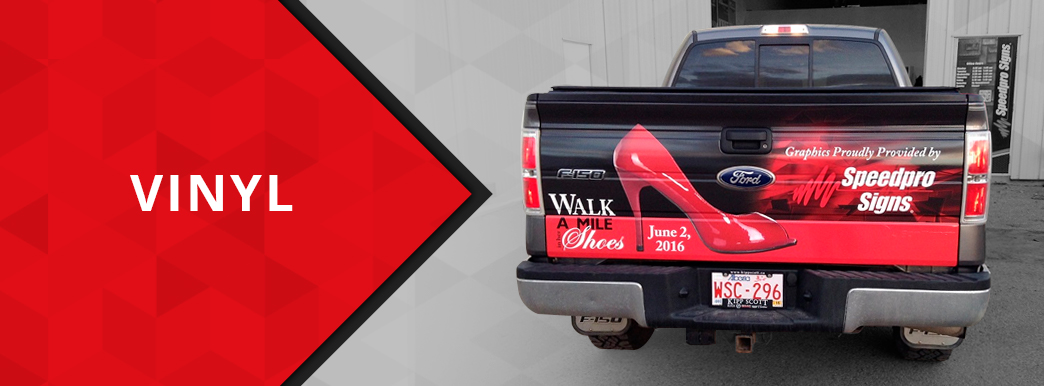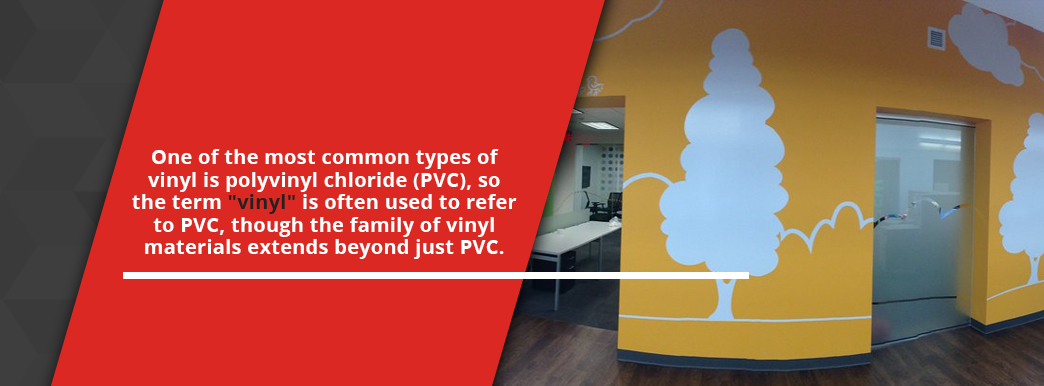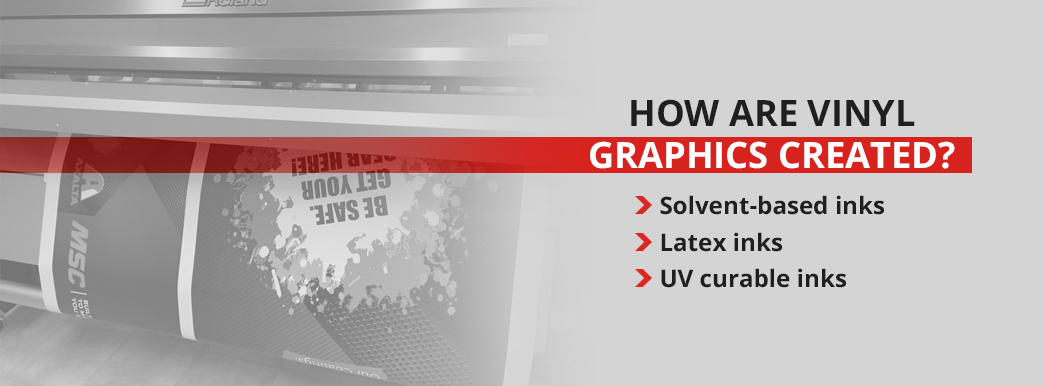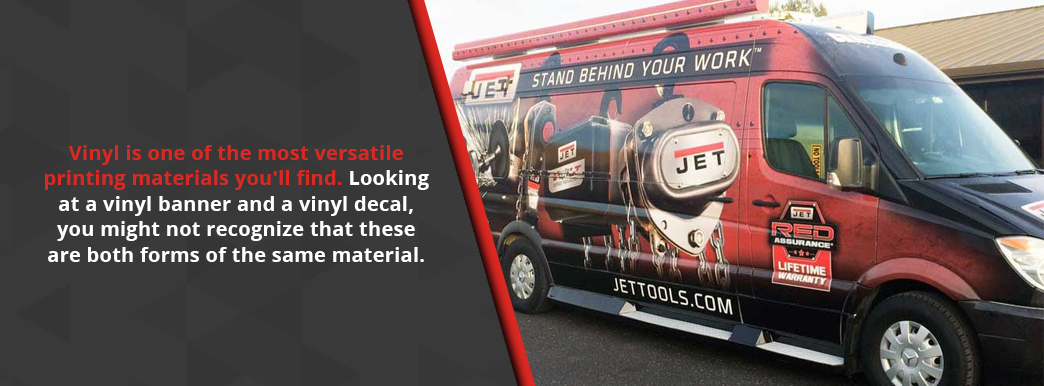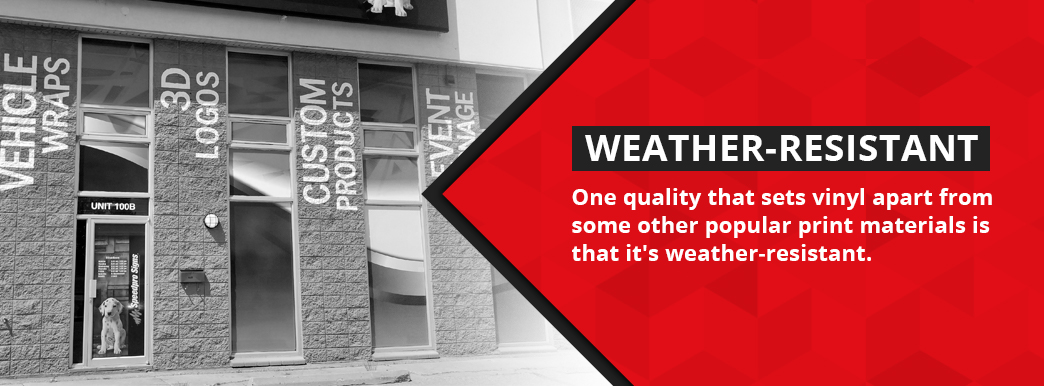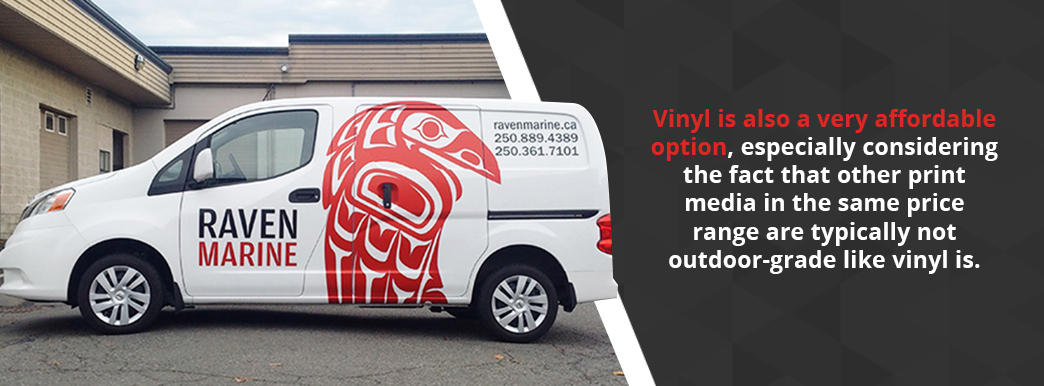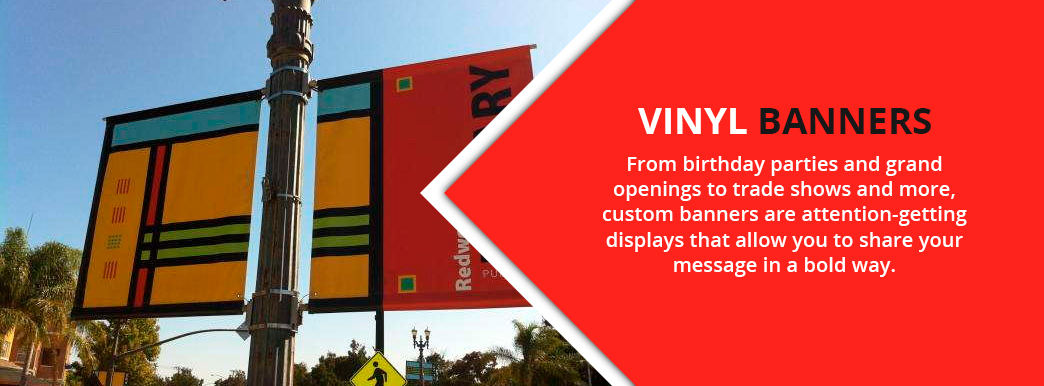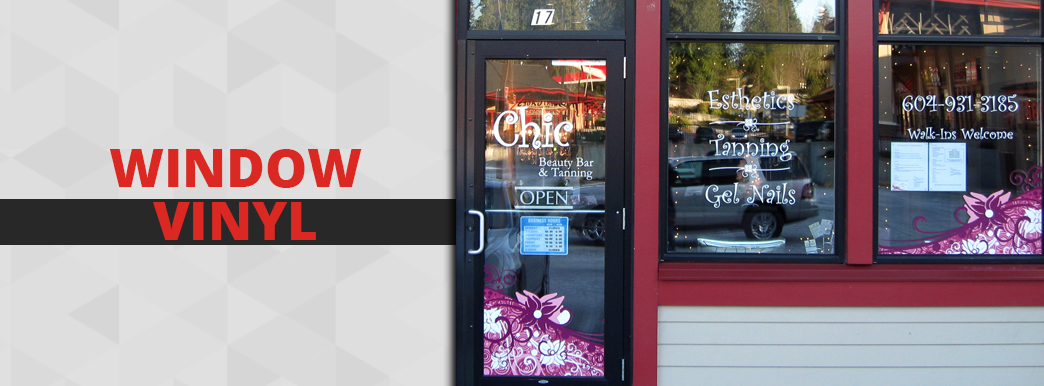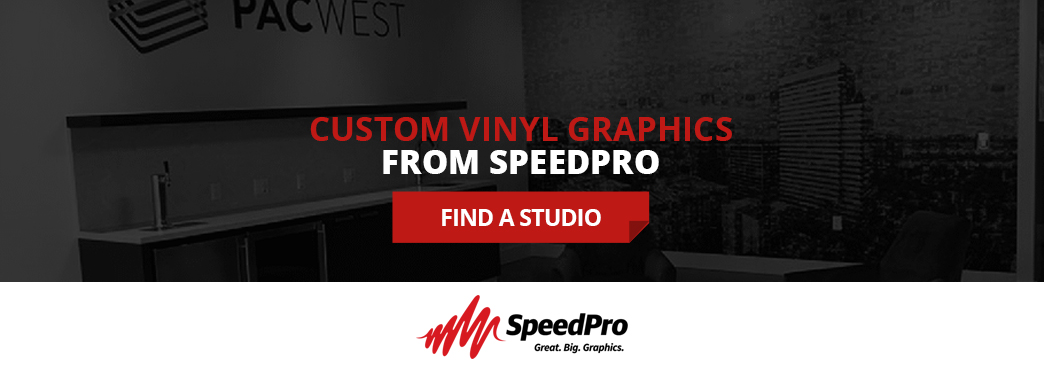From our bathrooms to our shoes, vinyl is seemingly everywhere. But have you ever considered this versatile material for your next print project? With its durability, affordability, convenience and endless opportunities for customization, vinyl is an excellent choice for a wide range of products. You can choose from several types of vinyl, and SpeedPro can help you find the perfect vinyl material for your next display.
What Is Vinyl?
Vinyl is a family of plastic materials derived from ethylene. One of the most common types of vinyl is polyvinyl chloride (PVC), so the term “vinyl” is often used to refer to PVC, though the family of vinyl materials extends beyond just PVC. Vinyl is an extremely versatile material, so it finds its way into our homes and businesses in a variety of ways, from shower curtains and plumbing pipes to flooring and more.
Vinyl is also a useful material for printing. The impressive level of versatility vinyl offers makes it a great option for many kinds of displays. Though vinyl can be a rigid material, vinyl displays are typically thin and flexible and may be transferred onto a surface. One of vinyl’s greatest advantages as a print media is that it can stand up to outdoor conditions, making it a great option for a wide range of applications.
How Are Vinyl Graphics Created?
Vinyl isn’t inherently an easy material to print on since it isn’t absorbent. However, modern printing methods make it possible to create vivid graphics on vinyl. There are two traditional methods that work for printing on vinyl along with a newer method:
- Solvent-based inks: This method involves melting the surface of the vinyl just enough for the ink to penetrate into the material. It results in a graphic that is durable in the face of outdoor weather. The printed image should remain sharp and vivid for years.
- Latex inks: Aqueous latex ink is another option since it bonds with the surface of the vinyl. However, latex inks won’t stand up to the elements as effectively as solvent inks. This method is a good option for temporary indoor displays since it’s easier and costs less than printing with solvent inks.
- UV curable inks: Ultraviolet (UV) curing is a more environmentally-friendly process that doesn’t require the use of solvents or high heat yet still yields a durable and weather-resistant product. The UV energy contributes to a chemical reaction that makes the ink instantly harden onto the vinyl.
For banners, the process ends when details like metal grommets are added to finish out the banner and make it easy to hang. For decals, the vinyl will typically be cut to create custom shapes. It may then be transferred onto another material, such as ultraboard or a table covering.
What Are the Benefits of Vinyl?
Vinyl is a popular printing medium because it offers some significant advantages that make it an excellent choice for many different types of signage. Vinyl is:
1. Versatile
Vinyl is one of the most versatile printing materials you’ll find. Looking at a vinyl banner and a vinyl decal, you might not recognize that these are both forms of the same material. Vinyl graphics can be transparent or opaque, adhesive or non-adhesive, large or small, indoor or outdoor. They can even be magnetic. Vinyl graphics can be hung up at trade shows, displayed in your business, adhered to windows, placed on vehicles and just about anywhere else you can think of.
2. Weather-Resistant
One quality that sets vinyl apart from some other popular print materials is that it’s weather-resistant. The key here is that vinyl is essentially water-proof. That’s why it’s a popular material for raingear, shower curtains and more. It’s also why it’s the perfect choice for outdoor displays. This includes outdoor banners and decals on the exterior of cars and windows. When you go with vinyl, you can expect your graphics to last outside long-term, no matter the weather.
3. Affordable
Vinyl is also a very affordable option, especially considering the fact that other print media in the same price range are typically not outdoor-grade like vinyl is. When you want to create a display that will last and look great without investing a lot of money, vinyl is a perfect choice. If you’re interested in a higher-end product like fabric but prefer not to pay for dye-sublimated graphics, you can have vinyl graphics transferred onto the fabric surface. This option still looks great and will help you save.
4. Convenient
Vinyl graphics are also a convenient option to choose for your next project because they’re easy to display. Vinyl banners are lightweight and easy to roll up or fold, making them excellent portable displays. When you get to your destination, it’s simple to hang up your banner by the grommets or to use a banner stand. Vinyl decals are also convenient to use. They allow you to display your custom graphics on nearly any smooth surface. This includes cars, elevators, windows, walls, floors and more.
5. Colorful
Finally, vinyl graphics can be vivid and colorful, which is helpful when you want to make a bold impression. Bright, colorful inks pop on a vinyl background. If you want to make an especially bold impression, opt for 10-foot vinyl banners, full-coverage elevator wraps or other large displays. If you’re interested in a more subtle color palette to complement your branding, that’s an option too. Frosted window signs are a great option for more subtle vinyl signage.
Types of Vinyl Displays
Since vinyl is such a versatile material, there are many types of custom displays made from vinyl. We’re going to look at the most popular types of vinyl displays, including vinyl banners, adhesive vinyl, magnetic vinyl and window vinyl.
1. Vinyl Banners
Vinyl banners are one of the most popular forms of vinyl displays. From birthday parties and grand openings to trade shows and more, custom banners are attention-getting displays that allow you to share your message in a bold way. You can also create banners from other materials, such as fabric, but vinyl is the quintessential banner material because of the many benefits we discussed above.
There are three types of non-adhesive printable vinyl that SpeedPro uses to create banners:
- Calendered vinyl: Calendered vinyl is an opaque, heavy-duty banner material that feels a bit like canvas. This is the most traditional option for general purpose banners. Since calendered vinyl is at least 3 to 6 millimeters thick, it’s rigid enough to hang flat against the face of a building or another surface without needing to be stretched out.
- Cast vinyl: Cast vinyl starts out as a liquid mixture and is heated until it becomes a solid. This opaque fabric-like vinyl is much thinner than calendered vinyl and is extremely flexible. Despite its light weight, it’s still very durable and strong. Cast vinyl banners can withstand the elements and last outside for years.
- Mesh vinyl: Whereas calendered vinyl and cast vinyl are opaque materials, mesh vinyl is perforated, which allows light and air to pass through the banner. Images on mesh vinyl banners may not appear quite as sharp up close as they do on opaque vinyl, but this translucent material is the best choice when you need two-way visibility, such as on a fence or window.
A SpeedPro staff member can help you choose the best type of vinyl substrate for your banner project depending on where and how you plan to display it. Let them know whether you’re looking for an outdoor vinyl sign material or a custom vinyl banner for a trade show or other indoor event.
In addition to the material itself, you can customize your vinyl banner in several other ways, including:
- Laminates: Though vinyl is a durable material in and of itself, you can protect your vinyl banner further by choosing to laminate it. In addition to providing a layer of protection, laminates can add your preferred finish to your banner, from matte to high-gloss.
- Mode of display: You can display banners in several different ways, the most common of which are hanging by grommets, attaching to a banner stand or mounting on a pole.
- Shape: Most vinyl banners are rectangular, but vinyl banners can come in other custom shapes, including cylindrical and shield shapes. You can also opt for a square rather than a narrow rectangle.
- Size: As a large-format graphics provider, SpeedPro can help you create massive banner displays. We can also create banners small enough to sit on a tabletop and every size in between.
- Graphics: The most important way to personalize your banner is through your custom graphics. SpeedPro uses inks to create colorful, professional images and can match your branded color palette.
2. Adhesive Vinyl
Another popular type of vinyl display is an adhesive vinyl decal. Printed adhesive vinyl is weather-resistant, meaning it’s suitable for both indoor and outdoor applications. Single-color decals may simply be cut from a pre-colored sheet of adhesive vinyl, while more intricate designs will be printed onto the vinyl then cut.
There are many different types of vinyl adhesives to choose from, depending on your intended application. These types of adhesives include:
- Changeable/repositionable: Changeable adhesive takes a little bit of time to fully adhere, which allows you to reposition your decal shortly after you apply it. This is a helpful feature that removes the pressure of getting your decal positioned perfectly the first time.
- Removable: If an adhesive is removable, that means you can peel off the adhesive without having to apply heat. The decal cannot be reapplied somewhere else after this, but it makes removal easier when you’re ready to dispose of a decal.
- Permanent: As the name suggests, permanent adhesives are designed to develop a strong bond with the surface where it’s applied so it will remain securely affixed to the surface over time. This works on a wide variety of surface types.
- High-tack/low-energy: Some materials, such as plastic and powder-coating, are difficult surfaces to adhere something to. This is where high-tack, or low-energy, adhesives come in. They are specially designed to stick to these surfaces.
- Air-release/air-egress: If you’re concerned about air bubbles getting trapped under your decal when you apply it, you may want to consider an air-release, or air-egress, adhesive. This type of adhesive is equipped with a micro pattern that allows air bubbles to be released.
Whatever type of adhesive you choose, vinyl decals are relatively simple to apply. When you’re ready to display a decal, you simply pull the adhesive-backed vinyl off of the backing paper and then stick the graphic to your desired surface, starting on one end and smoothing the decal out as you go.
Outdoor adhesive vinyl decals make it easy to add branding wherever you want it. This includes a variety of indoor and outdoor surfaces, including:
- Walls: Think of the walls in your home or business as a blank canvas. Adhesive vinyl decals give you a creative way of customizing your walls. For businesses, this can allow you to keep your branding prominently displayed throughout your business through text and logos or to inspire your employees or customers with eye-catching images that highlight the work you do.
- Floors: Don’t forget to take advantage of your floor space, as well. Custom floor graphics consist of a base of adhesive vinyl topped with a laminate coating that prevents skidding. Floor decals can help with wayfinding if your store, office or warehouse is large. They can also simply provide branding or advertising in a place where people are likely to look when they glance down at their phones.
- Elevators: Elevator wraps are another great option for adding advertising in an unexpected place. These wraps are essentially large decals that cover the doors and sometimes the interior of an elevator. Elevator wraps can be a great way of sharing your message since people waiting on or riding an elevator tend to view an advertisement as something of interest rather than an imposition.
- Giveaways: Smaller decals make it easy to turn any object, from a frisbee to a water bottle, into a branded product. This is great for giveaways at trade shows or community events where you want to hand out swag items for people to enjoy. Another option is to simply hand out decals by themselves. This way, people can place them wherever the want, such as on a laptop.
3. Magnetic Vinyl
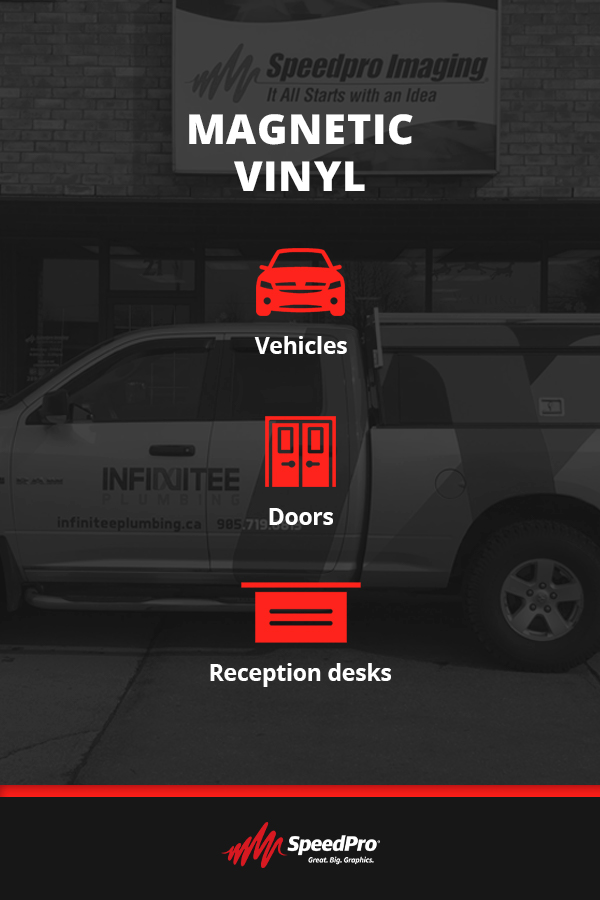
Common sizes for vinyl magnets are fairly large since they are typically made to place on a vehicle. These common sizes range from 12-by-18 inches to 18-by-24 inches. In addition to the size, you can customize the shape of your magnet with contour cutting that makes your graphic appear seamless rather than surrounded by empty white space.
Some possible applications for magnetic vinyl include:
- Vehicles: Vehicle wraps and decals are the most popular uses for magnetic vinyl. By using .030-gauge vinyl wrap magnets, SpeedPro can produce vinyl magnets for cars that will remain firmly in place, even when the vehicle is speeding down the highway. These magnets allow you to add branding to your commercial vehicles and advertise wherever you go.
- Doors: Building doors are often made of metal, and if they’re mostly solid rather than featuring large windows, they provide a great surface for a magnet. Use magnetic vinyl decals to welcome guests into your building or for wayfinding purposes, such as to label exits. You can also use magnets to get people’s attention with your temporary message when they open a door to a stairwell or an office.
- Reception desks: Some reception desks are made of metal, which makes them a perfect surface for a vinyl magnet. You can create a magnet with your logo to add some branding to your entryway and change it out only if you rebrand, or you can switch out magnets regularly to advertise upcoming sales or events.
4. Window Vinyl
The fourth type of vinyl display that is a popular choice is a window vinyl graphic. These graphics allow you to capitalize on the valuable advertising or decorative real estate of windows and enhance privacy without sacrificing your natural light. There are two main types of window vinyl:
- Perforated window vinyl: Perforated window vinyl is adhesive and designed for one-way viewing, meaning they are somewhat transparent from one side and display the graphic image on the other side. This makes perforated window decals for businesses perfect for company cars and other windows where you want privacy and visibility inside but want to advertise on the outside.
- Etched glass window vinyl: This type of vinyl decal is made to imitate the look of etched or frosted glass. Etched glass films work well on glass dividers or doors in workplaces, providing privacy and branding opportunities. With frosted vinyl printing, a pre-colored panel is cut to reveal your custom graphic, either using negative or positive space.
Window vinyl is, of course, intended for use on windows, though this is not limited only to exterior windows. It could also include any glass panels inside your business. Let’s look at a few examples of where you can apply window vinyl and how they can help you enhance that space:
- Vehicle windows: A common example of perforated adhesive vinyl is on the windows of a bus or other vehicle covered in advertising. From the outside, the windows — with the exception of the front windshield — appear to be covered in opaque color graphics, but the driver and passengers on the inside can still see out of the windows. Perforated vinyl intended for vehicles should be 50/50 — a measurement of how transparent they are.
- Retail windows: Retail stores often have large windows on their storefront. Especially if you want to advertise to passersby on the sidewalk or road, these windows are a great place to do it. You can use perforated window vinyl to create semi-permanent displays or temporary promotional messages. In the case of retail windows, the level of transparency can be 60/40, 65/35 or 70/30, meaning they are more opaque than vehicle window vinyl.
- Glass dividers: Glass walls are a common feature in many office spaces to divide the space while maintaining an open feel. These walls are the perfect place to apply etched or frosted vinyl for glass surfaces. In addition to office spaces, doctor’s offices and other businesses that may be located in a business suite often have glass walls to welcome visitors into their lobby. Adding branding here is a great way to show people they’ve come to the right place.
- Glass doors: Glass doors are extremely common in businesses, both inside the building and on the exterior. If you only have an open sign on your business’s front door, consider adding some elegant etched glass branding. You can also use etched glass window vinyl to post your hours or other useful information. You can enhance the look of interior glass doors by adding your logo or even just a simple frosted privacy window film panel.
Custom Vinyl Graphics From SpeedPro
SpeedPro leads the way in custom large-format graphics, so you can trust one of our studios to help you create eye-catching displays that look great and function how you need them to. If you’re considering creating a banner or decal from vinyl, contact your local SpeedPro studio and see how SpeedPro staff can help you bring your vision to life. With professional expertise, access to an extensive range of materials and cutting-edge print technologies, SpeedPro is your trusted partner for quality vinyl displays.

















